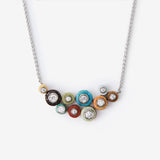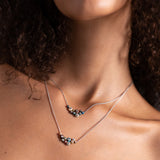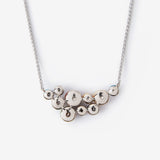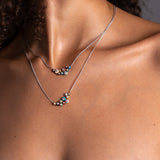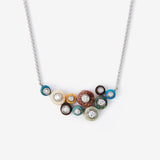REVIVAL CLUSTER NECKLACE
ORIGINAL ANTIQUITY
ANCIENT · EGYPT
We attend all our customers personally. Please leave us your contact details for information and sales.
We attend all our customers personally. Please leave us your contact details for information and sales.
DESCRIPTION
ORIGINAL EGYPTIAN FAIENCE BEADS (1550–1069 BC) · Egyptian faience stands for innovation in accessories for kings, nobles and commons. These beads are individually selected in unique colour combinations, and carefully revived in a contemporary design.
Finished with diamonds set in white gold, these 3000 year old coloured beads make this creation both timeless and forever.
Available in different colour sets
Lightweight design
18k palladium white gold
10 VVS G grade diamonds, total weight 0.23 carats
Chain length 42cm/16.5”

EGYPTIAN FAIENCE BEADS (1550–1069 BC)
Egyptian faience is a sintered-quartz ceramic material from Ancient Egypt. It was widely used for small objects, and is found in both elite and popular contexts. The ancient Egyptians gave faience a wide variety of uses, from tubular blue beads strung together in a net pattern, to coloured necklaces and even beaded masks.
This specific group of coloured beads originally comes from two English and French collections, traced back to Flinders Petrie (1853-1942), a legendary Egyptologist, mentor to Howard Carter.
Coloured faience beads were very popular in ancient Egypt, and were widely used for body jewelry.



-
B. Brier, Egyptian mummies: unraveling the secrets of the ancient art
-
B. Brier, Egyptomania: our three thousand year obsession with the land of the pharaohs
-
P. Remler, Egyptian mythology (chapter about the opening of the mouth ceremony)
Acquired at an antiquities dealer in London, legally exported under the British and European legislation for export of cultural goods. Authenticity has been certified by C.M., member of the British Treasure Valuation Committee and Deputy Chairman of ADA (Antiquities Dealers Association).
This specific group of beads originally traces back to two English and French collections. One comes with an aclaratory note that directly relates to an excavation at Gusob by Flinders Petrie (1853-1942), a legendary Egyptologist, mentor to Howard Carter.
REVIVAL
Egyptian faience is an early glazed ceramic, made of quartz, heat and colour. For a culture obsessed with revival, it was sand reborn by divine sun. Science to us, magic to them, it is one of many innovations that came out of centuries of cult for light and new life.

A year ago we had the opportunity to acquire a collection of faience beads with an exceptional provenance linked to Flinders Petri, a legendary Egyptologist. The objects as such were of little interest. Small, discrete, and long ago isolated from their historical context. Yet, more than any other, these humble coloured beads stand for all our brand is about.
Collectionism exhibits treasures of the past to be seen again. Oktaaf creates designs for the future, to be lived again. Ancient Egyptian artefacts were built for the sole purpose of resurrection. In a tribute to a cult of revival, we have given new life to this old faience.
Invariably, every Egyptian burial ceremony ended with a single prayer. “You shall walk and speak, your body shall be with the great company of the gods. You are young again, you live again. You are young again, you live again. Forever.”
Inspired by the past, designed for the future, our Revival collection is a timeless play of colour and light.






